Safety on the Sea
Safety Initiatives of Vessel Operations
Based on our mission statement "Bringing value to life", the Group is playing a part in customers' supply chains and supports the daily lives of people. In the shipping industry where vessels, which are the frontline of safe operations, operate far away from shore offices, NYK believes that sharing the goals with everyone involved, steadily continuing the activities, and completing the PDCA cycle is paramount. The Group pursues safe operation from all aspects, such as maintaining a system that aims for zero accidents, implementing initiatives based on original safety standards, fostering human resources development, and preventing accidents before those occur by utilizing advanced technologies like ICT (information and communication technology).
Safety and Environmental Management Committee
Based on the awareness that ensuring safe vessel operations underpins the NYK Group's business activities, the Safety and Environmental Management Committee, chaired by the president, was established in 2001, and offshore and onshore personnel around the world make a concerted effort to promote the safety and environmental activities. Every year, the committee reviews the activities conducted the previous year and decides the activity policy and goals for the current year. Also, the activity policy decided by the committee is translated into specific activities by the sub-committees for each ship type and executed as safety enhancement activities for each ship.
Safety and Environmental Management Committee (SEMC)
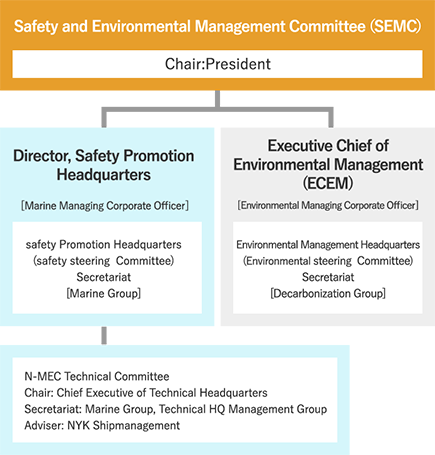
- *N-MEC Technical Committee
The purpose of this committee is to review seafarer training policy and the knowledge and skills seafarers need for our vessels.
- More information:
Downtime*1 measurements
The Group uses ship-stoppage due to accidents or problems (i.e., downtime) as an indicator of the degree to which we have achieved safe ship operations, with the goal of reducing delays to 10 hours or less per vessel in operation.
Trends in Downtime
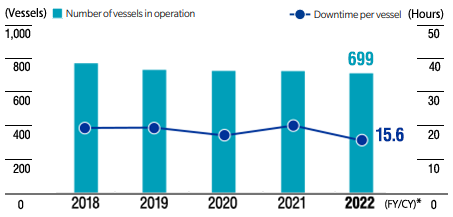
- *1Downtime is the total duration in which vessel service has stopped due to a collision, grounding, engine accidents, etc.
- *2From 2020, the calendar year (CY) is used instead of the company's fiscal year (FY).
Thus, January-March 2020 data contained in FY2019 is also included in CY2020.
As one means of achieving the goal of "zero" downtime, the Group has conducted research into predicting and preventing ship equipment failures through the use of IoT and big data, and we have a system that enable onshore personnel to also support safe operations.
Number of SIMS*1 -equipped Vessels and Number of Anomaly Incidents
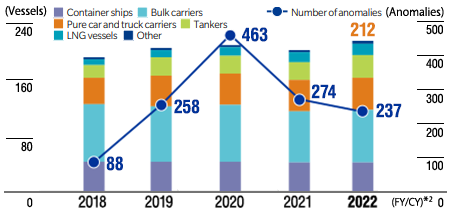
We use SIMS data to conduct anomaly analyses to monitor and reduce ship engine troubles and grounding risk.
- *1SIMS(Ship Information Management System)
SIMS allows us to monitor in real time detailed data during navigation, starting with data from engines and all kinds of equipment through to vessel speed and vibration, as well as weather information like wind speed and tidal currents. All the data is shared between vessels and worksites onshore. - *2From 2020, the calendar year (CY) is used instead of the company's fiscal year (FY).
Thus, January-March 2020 data contained in FY2019 is also included in CY2020.
- More Information:
Safety Management System
In order to maintain the quality of the operational vessels, safety management is thoroughly enforced based on the Group's unique, standardized safety standards NAV9000.
- More Information:
Safety Campaigns
NYK regularly conducts safety enhancement campaigns to foster a corporate culture that embodies safety. Personnel engaged in onshore and offshore operations exchange opinions and deepen their mutual understanding about a main theme that is set based on current priorities. During the campaign period, many executives and employees visit vessels to talk directly with crew members about safety. Moreover, NYK creates opportunities for further discussion with representatives from shipowners and shipmanagement companies to get its safety activities to the frontline of vessel operations.
NYK strengthens its culture of safety through various materials, such as the company's "Casualty Report" for flash reports about accidents, "Safety Bulletin" for strategies to prevent accidents and problems, "Marine Engineering Information" for technical matters, and "Security Information" for security issues.
- *Safety campaigns: "Remember Naka-no Se"(Summer season), "Sail on Safety"(Winter season)
NYK hold safety campaigns twice a year, in summer and winter. Summer campaigns are based on the lessons learned from the stranding of the very large crude-oil carrier (VLCC) Diamond Grace in Tokyo Bay in 1997. Winter campaigns mainly focus on preventing marine accidents, including those resulting from rough winter weather. Executives and employees who visited vessels engaged in face-to-face dialogue to heighten awareness.
Near Miss 3000 Activities
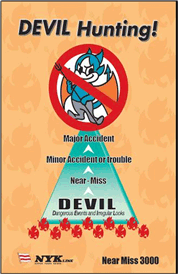
Our Near Miss 3000 activities aim to prevent accidents. Under the slogan "DEVIL Hunting!", since 2006 the Group has been working with partner shipowners and shipmanagement companies to advance activities that are based on Heinrich's Law and which seek to nip accidents in the bud by identifying and dealing with the often over-looked precursors to accidents, or "DEVIL"
In these activities, our goal is to create environments that are safer and easier to work in by increasing crew members' safety awareness. Through the consistent performance of routine duties with an awareness of safety, crew members help prevent collisions, equipment breakdowns, and accidents during work.
- *DEVIL Hunting!
'DEVIL' is derived from 'Dangerous Events and Irregular Looks'. The purpose of these activities is to eliminate at the very early stages the precursors and factors to accidents before a major event occurs.
Number of DEVIL Reported
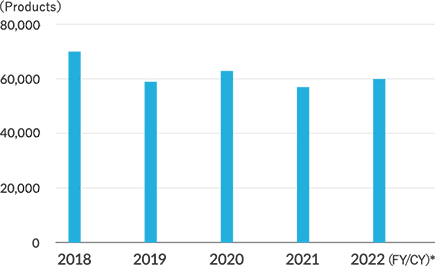
Calender 2023 DEVIL Causes
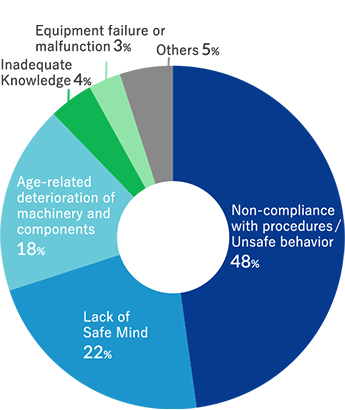
- *From 2020, the calendar year (CY) is used instead of the company's fiscal year (FY). Thus, January-March 2020 data contained in FY2019 is also included in CY2020.
Offshore-onshore information-sharing via "Calm Sea"
Up-to-date information, such as the degree of achievement of safe operations, examples of Near Miss 3000 activities, lessons learned from the accidents, and environmental measures are notified to the shipowners, shipmanagement companies, and all operational vessels through the monthly newsletter "Calm Sea", and information is shared between onshore and offshore personnel.
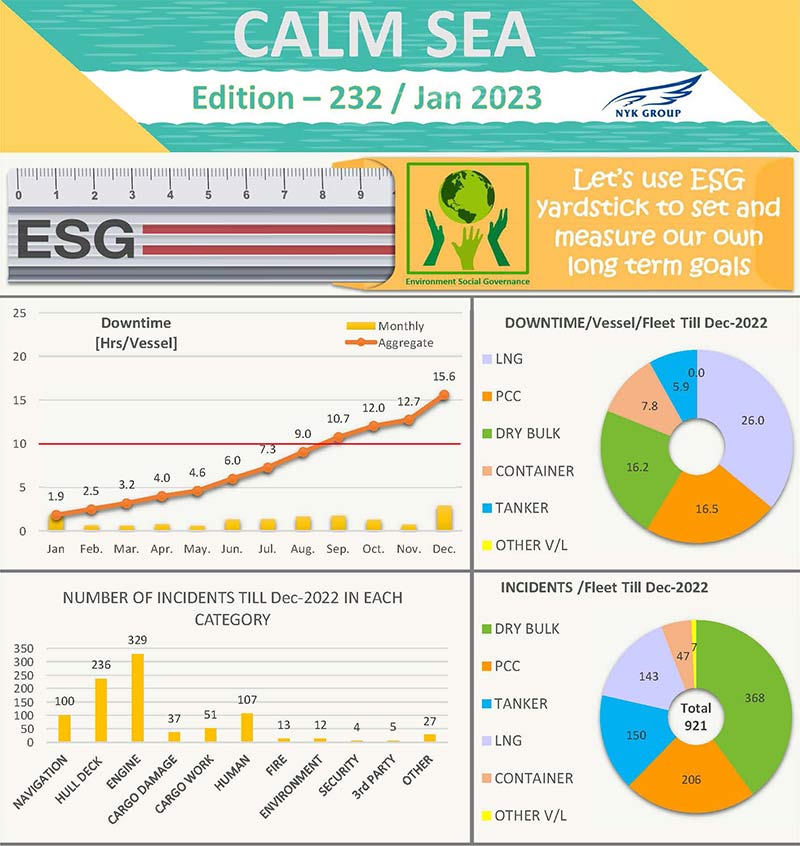
In our newsletter "Calm Sea," we publish frequent cases of near misses indicated by our vessels.
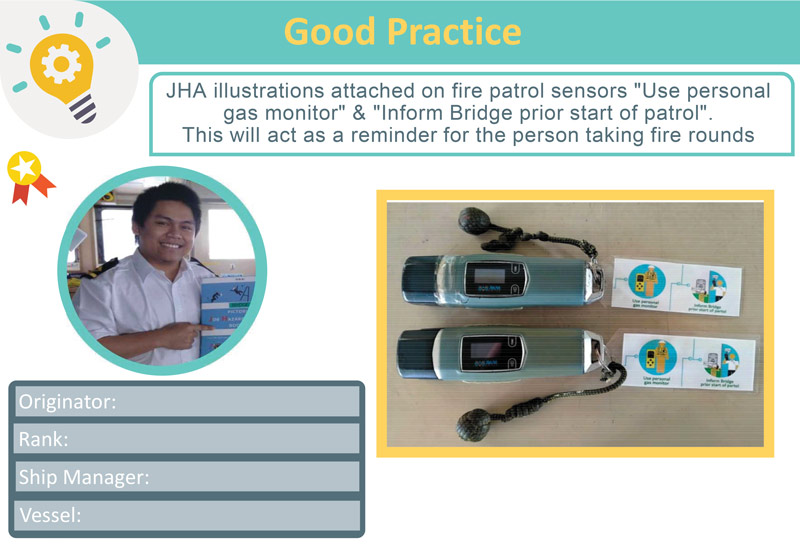
Marine Accident Readiness
Emergency Response Network
The Group has created an emergency response network based on four overseas regional blocs to be ready for maritime accidents and problems around the world.
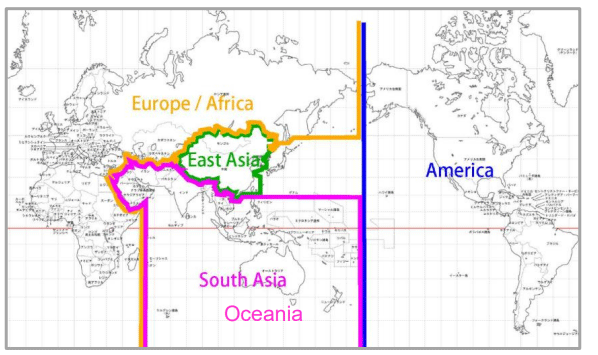
Ongoing emergency response exercises
We conduct regular emergency response drills to ensure a swift response in the event of an accident. To make the training more realistic, we change the type of ship, its size, and the nature of the accident or issues for each session so that we can respond flexibly to actual accidents when they occur. During these drills, we have participation not only from operational ships and ship management companies but also from various external parties such as Japan's Ministry of Land, Infrastructure, Transport and Tourism, the Japan Coast Guard, the Japanese Shipowners' Association, and our customers. The drills are conducted with a level of tension akin to that of an actual emergency. Upon receiving a report of an accident from the vessel, we promptly establish an accident response headquarters and, in coordination with external parties, we undertake rescue operations and ensure the safety of nearby vessels. Additionally, we conduct simulated press conferences to disclose information appropriately as the situation develops.

